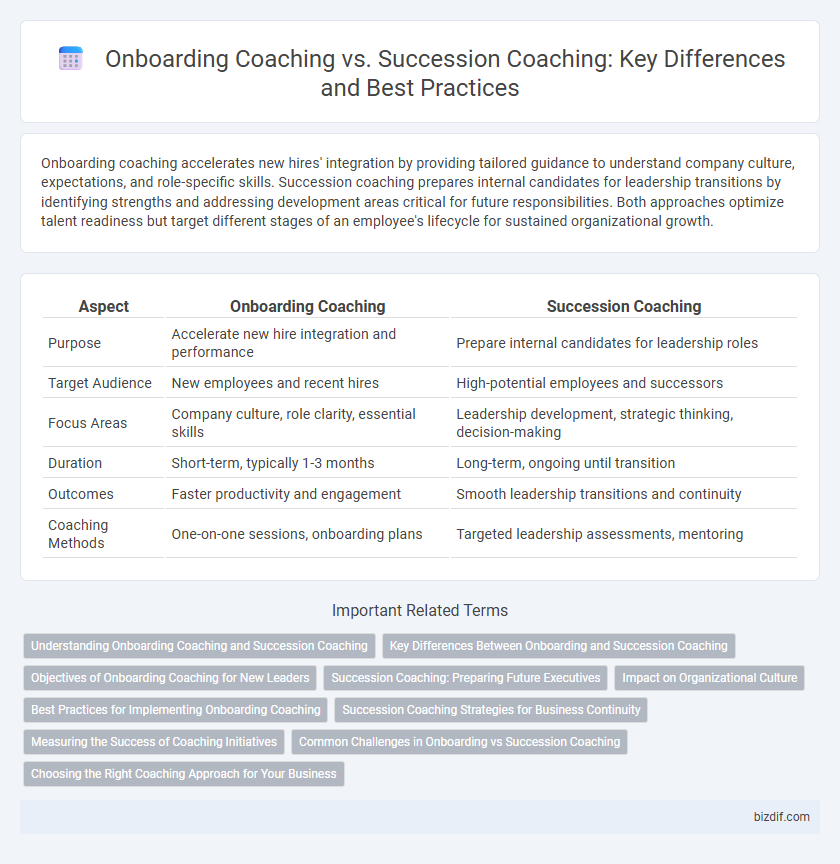Onboarding coaching accelerates new hires' integration by providing tailored guidance to understand company culture, expectations, and role-specific skills. Succession coaching prepares internal candidates for leadership transitions by identifying strengths and addressing development areas critical for future responsibilities. Both approaches optimize talent readiness but target different stages of an employee's lifecycle for sustained organizational growth.
Table of Comparison
| Aspect | Onboarding Coaching | Succession Coaching |
|---|---|---|
| Purpose | Accelerate new hire integration and performance | Prepare internal candidates for leadership roles |
| Target Audience | New employees and recent hires | High-potential employees and successors |
| Focus Areas | Company culture, role clarity, essential skills | Leadership development, strategic thinking, decision-making |
| Duration | Short-term, typically 1-3 months | Long-term, ongoing until transition |
| Outcomes | Faster productivity and engagement | Smooth leadership transitions and continuity |
| Coaching Methods | One-on-one sessions, onboarding plans | Targeted leadership assessments, mentoring |
Understanding Onboarding Coaching and Succession Coaching
Onboarding coaching accelerates new employees' adaptation, focusing on skill development and organizational culture integration to ensure early productivity. Succession coaching prepares high-potential leaders for future roles by enhancing strategic thinking, leadership capabilities, and succession planning readiness. Both coaching types optimize talent management but target distinct career stages and organizational needs.
Key Differences Between Onboarding and Succession Coaching
Onboarding coaching primarily targets new employees, accelerating their adjustment and performance within the organization by focusing on cultural integration and role clarity. Succession coaching centers on preparing high-potential leaders for future executive responsibilities, emphasizing leadership development, strategic thinking, and long-term organizational impact. The key differences lie in their objectives, timelines, and target audience--onboarding coaching ensures immediate productivity while succession coaching fosters sustained leadership continuity.
Objectives of Onboarding Coaching for New Leaders
Onboarding coaching for new leaders focuses on accelerating leadership effectiveness by aligning their skills with organizational culture and expectations. It aims to build confidence, clarify roles, and establish strong communication channels to ensure a smooth transition into leadership responsibilities. This coaching also prioritizes goal setting and performance management to drive early success and long-term retention.
Succession Coaching: Preparing Future Executives
Succession coaching is a strategic process designed to prepare high-potential employees for leadership roles by enhancing their decision-making, communication, and strategic thinking skills. It focuses on aligning future executives' capabilities with organizational goals to ensure seamless leadership transitions and sustained business growth. By identifying and nurturing key talents early, succession coaching mitigates risks associated with leadership gaps and strengthens succession pipelines.
Impact on Organizational Culture
Onboarding coaching accelerates new employees' integration, fostering a culture of inclusivity and continuous learning from the outset. Succession coaching strengthens leadership pipelines, reinforcing values of accountability and strategic thinking that permeate organizational culture. Both coaching types synergize to create a resilient culture aligned with long-term business goals.
Best Practices for Implementing Onboarding Coaching
Implementing onboarding coaching effectively requires a structured approach that includes clear goal setting, personalized development plans, and consistent feedback loops. Best practices emphasize integrating onboarding coaching with company culture to accelerate new hire productivity and engagement. Leveraging experienced coaches to mentor newcomers ensures smoother transitions, reduces turnover, and aligns talent with organizational objectives.
Succession Coaching Strategies for Business Continuity
Succession coaching strategies prioritize identifying and developing high-potential leaders to ensure seamless business continuity during leadership transitions. Tailored coaching plans focus on strengthening decision-making, strategic thinking, and emotional intelligence to prepare successors for critical roles. Integrating regular assessment and feedback mechanisms enhances readiness, reducing operational risks associated with leadership changes.
Measuring the Success of Coaching Initiatives
Measuring the success of onboarding coaching involves tracking employee ramp-up time, engagement levels, and early performance metrics to ensure smooth integration and skill acquisition. Succession coaching success is evaluated by assessing readiness for leadership roles, retention rates of high-potential employees, and the smooth transition of critical responsibilities. Data-driven insights, such as feedback surveys and performance analytics, provide quantifiable evidence of coaching impact in both onboarding and succession planning initiatives.
Common Challenges in Onboarding vs Succession Coaching
Onboarding coaching often faces challenges such as accelerating new hire integration, clarifying role expectations, and building early confidence in unfamiliar environments. Succession coaching struggles primarily with developing long-term leadership capabilities, managing stakeholder expectations, and facilitating smooth transitions of critical organizational roles. Both coaching types require tailored strategies to address unique hurdles related to timing, scope, and impact on organizational continuity.
Choosing the Right Coaching Approach for Your Business
Onboarding coaching focuses on integrating new employees effectively by enhancing role clarity, cultural alignment, and early productivity, while succession coaching prepares high-potential talent for future leadership roles through skill development and strategic insight. Selecting the right coaching approach depends on your business goals--prioritize onboarding coaching to accelerate new hire impact, or succession coaching to ensure leadership continuity and organizational resilience. Evaluating workforce needs and long-term objectives enables targeted investment in coaching that drives sustainable growth and employee engagement.
Onboarding coaching vs succession coaching Infographic

 bizdif.com
bizdif.com